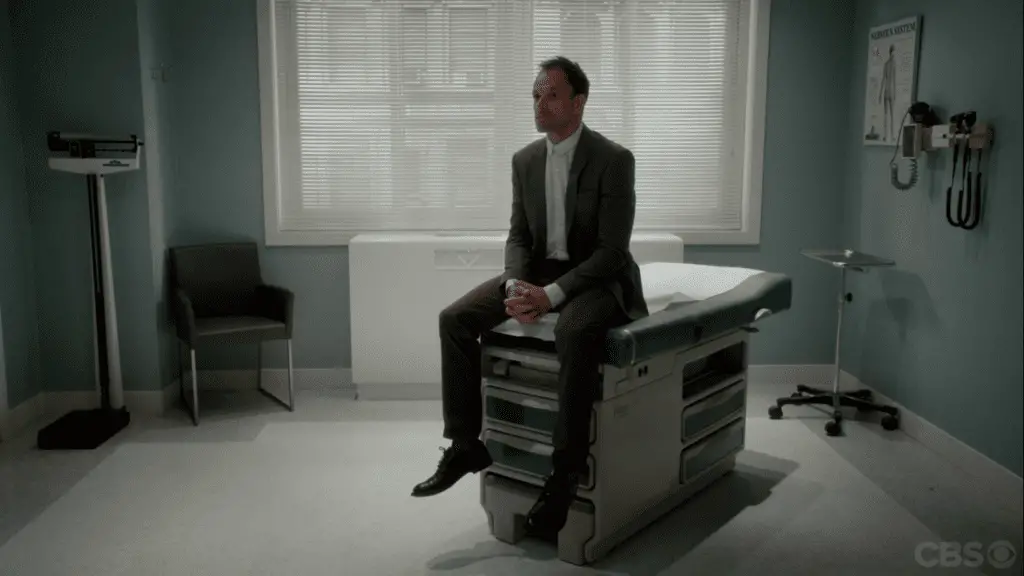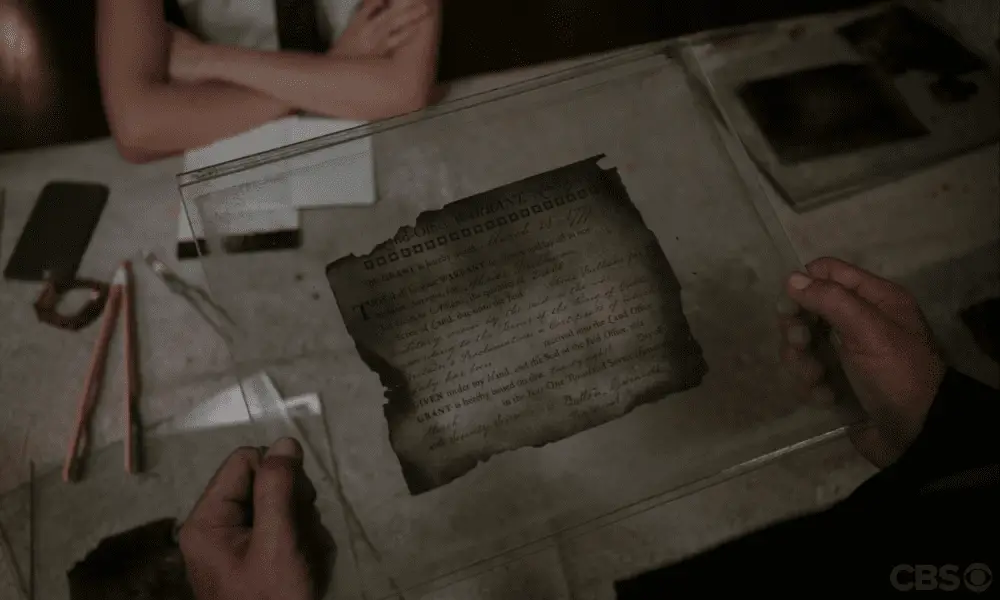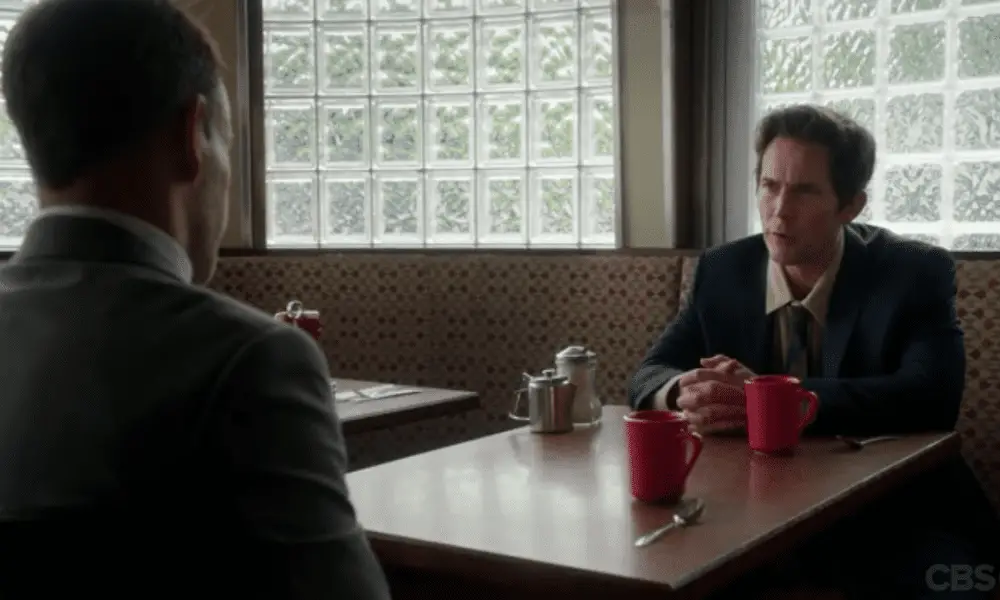When you watch enough murder mysteries, you start to recognize the classic tropes. Of those, one of the more random ones might be “Historical Reenactment.” I’m sure that academics and professors have all sorts of interesting ideas on why reenacting history is a murder mystery trope. But I think it’s because you get to have that “Oh, we’re all playing dead for historical accuracy, hey wait, isn’t that dude really dead?” moment.
A group of Revolutionary War reenactors are playing out the iconic Battle of Harlem Heights. Among the “deceased” Redcoats, one man turns out to have taken a real gunshot wound to the chest during a salvo of blanks. He’s very dead.
Sherlock and Gregson interview the would-be soldiers, only to find varying accounts of what happened and what the potential killer may have looked like. The only helpful information is that one soldier was familiar enough with guns to have heard a distinctively modern gunshot among the musket fire.
Joan and Bell have more luck with other witnesses. It turns out the victim, a George Nix, had his own personal bodyguard. Nix had insisted the guard would be out of place in the reenactment and had left him on the sidelines. He was unable to protect his client, he has plenty of information. Nix had owned a gym company where individuals could buy franchises, but only at a steep cost. It was essentially a pyramid scheme, leaving many people broke. Some of his dissatisfied customers sent him death threats. That’s what the kids call a Clue.
After the battlefield, Sherlock heads to a doctor’s appointment. His headaches and sensory overstimulation are getting worse, not better, and he’s frustrated. He’s also anxious about becoming addicted to the meds prescribed to help with his symptoms. His doctor insists that recovery will take time and that he’s unlikely to form an addiction.

Sherlock is dramatic even when he’s suffering, and Joan walks in on him in the brownstone wearing an enormous welder’s mask. It helps block out the computer glare hurting his eyes. She proposes a better solution would be to not spend so long on the computer. But Sherlock has found something. Among the gym-related threats, which he dismisses, is an email chain from Nix’s daughter. The two were estranged, and she threatened to kill him if he came looking for her. Joan heads out to find her while Sherlock meets up with Michael.
You remember Michael, right? Sherlock’s new friend, you know, the one that was burying a dead woman out in the forest? Totally not suspicious. Sherlock meets Michael at his office, where he’s looking at social media photos of that same young woman. He shuts his computer off before Sherlock can see and the two go get coffee together. They discuss Sherlock’s PCS and his anxiety about his medication. Michael has good advice and encourages Sherlock to lean on Joan and NA, but…I don’t trust him.
Nix’s daughter is living on a commune in upstate New York. She blames capitalism for Nix’s death and denies any wrongdoing of her own. She has an alibi for his time of death, and there’s no way she could have ordered a hitman on her father. All technology is banned on the commune, so she couldn’t have even gotten in contact with such a person.
That’s a dead end. (Get it? Because it’s a murder investigation? Ah, I make myself laugh.) But as they leave the commune, Bell gets a call from the captain. Someone just burned Nix’s house down.
The investigation confirms it was arson. The accelerant used was a combo of dangerous chemicals that makes an incredibly hot fire. Unfortunately, the accelerant ingredients are common household items and recipes to make the accelerant are available online. There was no DNA or fingerprints at the crime scene, but there was something else. A footprint, tracking mud from the scene of the murder. The arsonist and killer are probably the same person.

Looking at the crime scene photos, Joan notices something. Nix had a collection of expensive silver once belonging to Paul Revere. But there’s no trace of the silver in the wreck of the house. That would be a big score. The fire may have been to cover up the theft. But if the theft was the goal all along, why kill Nix?
Sherlock’s new meds make him sleep more and more deeply and he sleeps through the conversation I just described. Joan gently reminds him that rest is key to his recovery.
The two head to the Property Crimes division and meet up with a Detective Mason. He and Sherlock worked together on a case back when Sherlock first came to NYC. Considering Sherlock’s current success, he resents that he was never able to work with Sherlock again. He’s the best detective for crimes involving stolen historical artifacts, but in exchange for his help, he has a test. He hands Sherlock a file for a bizarre crime and asks him to work on it. Sherlock promptly solves it. Mason reluctantly shares a list of places that the silver may have been fenced.
It’s a good lead. Joan, Sherlock, and Bell bring in a firefighter who was at the scene of the arson. He was trying to sell the silver to a pawn shop. But he insists that he’s not responsible for the murder or the fire. He stole the silver along with a safe simply because he had the opportunity to do so when fighting the fire. To prove his innocence, he shows them the stolen silver and the safe. They were destroyed. If his goal was to steal the silver, why set a fire that would ruin it?
The next morning, Joan wakes up to Sherlock making a racket in the kitchen. Our first “Sherlock annoys Joan into waking up” of the season! Sherlock realized that they had missed a clue regarding the fire. The particular accelerant used creates a fire that burns incredibly hot. Nix’s safe was built to be resistant to the heat of a normal fire, but the arson burned so hot that the documents the safe contained were destroyed. He now thinks that was really the point of the fire.

But luckily, Sherlock has some tricks up his sleeve, and he knows a way to restore documents exposed to heat damage. More clues! The documents were indeed something significant. A collection of signatures belonging to a man with the unusual name of Button Gwinnet. For once this is not a name we can blame on the unique tastes of the Elementary writers. Gwinnet was a real person from the Revolutionary era, a governor of Georgia and one of the signers of the Declaration of Independence.
For that reason, his signature is highly sought after and expensive. There are collectors who wish to form complete collections of the signatures of everyone who signed the declaration. Gwinnet’s signature is the rarest and thus most valuable. They theorize that someone attempted to destroy Nix’s Gwinnets in order to drive up the price of the surviving signatures.
Working on that theory, the detectives interview a historian and art collector. He was another Gwinnet collector and he’d tried to buy Nix’s Gwinnets in the past. Even more suspicious, he was actually at the battle reenactment. But he insists that he views historical documents such as the Gwinnets as being sacred artifacts and he would never try to destroy them. Besides, he had no reason to do so. Nix had been struggling financially due to the scandal surrounding his gyms and had recently offered to sell his Gwinnets.
Sherlock makes another effort to communicate with his doctor. By breaking into his office, as one does. He’s frustrated with the way his meds are affecting his sleep patterns. But Sherlock’s doctor firmly insists that if Sherlock’s meds aren’t working, the best alternative is for Sherlock to take a break from his work all together. Go on vacation. Chill. But I’ve been watching this show long enough to know that Sherlock Holmes has no chill.

After re-examining the clues, Joan has a new theory of the case. The arsonist/killer didn’t want to destroy the signatures, they wanted to destroy the documents the signatures were on. Most of the papers are trivial, but one catches her interest. In Revolutionary times, the newly formed states would offer land in exchange for soldiers joining the army. There’s one such land offer among the documents for a specific soldier. But in an incident called the Yazoo Land Scandal, the land was sold to someone else. Now, that soldier’s modern day descendants are suing to get the land back. The document belonging to Nix would have made the case and cost the current owner of the land a lot of money.
The soldier’s descendants are suing an NYC-based land developer. One that Sherlock realizes he’s already encountered in the course of the case. They have their killer. The only problem now…is how to prove it. The gun from the murder has vanished, even though the police carefully checked the guns of all the reenactors. They also have no proof of the arson.
Since the twist in this episode turns out to be not so much who did it, but how to prove their guilt, I won’t say how Joan and Sherlock figure it out. But it involves a lot of poo.
The case successfully solved, Sherlock and Michael meet up again. Michael has been thinking about what Sherlock told him. So has Sherlock. He’s actually contemplating taking the doctor’s advice of going on vacation. But Michael has a counter offer. A new case. A woman he knows from the meetings has gone missing. Guess who the woman is? Yeah, that’s right, that woman we saw Michael burying in the season premiere.

Thoughts:
- This was a stronger mystery than last week. Lots of fun trivia, based on real, historical events, and a good, solid murder! That’s what I like to see! (Note: don’t say that in real life.) However, I’m disappointed that Joan and Sherlock didn’t don any Revolutionary era costumes.
- I’m not sure what was up with Detective Mason. Considering he was only in the episode for about five seconds, I’m not sure why they bothered to retcon him a history with Sherlock. Maybe he’s going to show up again later?
- What is Michael playing at? Is he going to be one of those cliche fictional murderers who longs for a worthy adversary? But I’m also contemplating the fact that although we saw Michael bury that woman, we didn’t see him kill her. I had him pegged as a serial killer at first, but maybe something else is going on.
- Speaking of Michael – I like to see Sherlock interact with other people in conversations that aren’t related to crimes or his NA meetings. He’s often pretty awkward, both in the things he says and in the way that Miller plays his body language. It reminds you that there’s a side of Sherlock that’s not a Super Genius Mystery Solving Machine, that he’s also an awkward nerd that doesn’t know how to make small talk. It’s so humanizing and endearing.
- Only Sherlock would view vacation as a punishment. I, personally, would love to go on vacation. And I went on vacation literally last month.
- I’m so mad about the pun in the episode title. Pushing Buttons…Button Gwinnett…I won’t forgive you for this, Elementary writers.

